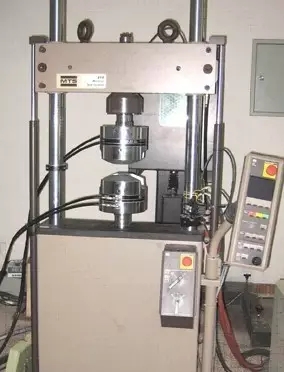Fatigue test can predict the fatigue strength of materials or components under alternating load. Generally, the test period is longer and the equipment required is more complicated, but due to general mechanical tests such as static tensile, hardness and impact tests, It is able to provide the performance of materials under repeated alternating loads, so it is necessary to perform fatigue tests on important components.

MTS 810
Some common test methods for metal material fatigue test usually include single point fatigue test method, lifting method, high frequency vibration test method, ultrasonic fatigue test method, infrared thermal image technology fatigue test method and the like.
>>>>Single point fatigue test method
It is suitable for the service of metal material components under the conditions of room temperature, high temperature or corrosive air under bending and bending load. In this method, when the number of samples is limited, the fatigue curve can be approximated and the fatigue limit can be roughly estimated. The fatigue testing machine required for the test is generally a bending fatigue testing machine and a tensile testing machine.
>>>> Lifting fatigue test
Lifting fatigue test is a relatively common and accurate method to obtain the fatigue limit of metal materials or structures. The fatigue strength of materials or structures based on the fatigue strength test or the specified life can not be directly determined by the test. In the case of the fatigue strength, the fatigue strength is generally measured indirectly by the lifting method fatigue test.
It is mainly used to determine the random characteristics of material or structural fatigue strength in medium and long life zones. The required testing machine is generally a tensile and fatigue testing machine.
>>>>High frequency vibration fatigue test method
In the conventional fatigue test, the frequency of the alternating load is generally lower than 200 Hz, and it is impossible to accurately measure the fatigue damage of some parts in a high-frequency environment. The high-frequency vibration test uses the test equipment to generate an alternating inertial force with a cyclic load frequency of about 1000 Hz to act on the fatigue specimen, which can satisfy the fatigue performance of the metal material in high frequency, low amplitude and high cycle environment.
The high frequency vibration test is mainly used for the needs of military and civilian mechanical engineering. The test device usually includes a controller, a charge adapter, a power amplifier, an accelerometer, a vibration table, and the like.
>>>>Ultrasonic fatigue test
The ultrasonic fatigue test is an accelerated resonance fatigue test method whose test frequency (20 kHz) far exceeds the conventional fatigue test frequency (less than 200 Hz). Ultrasonic fatigue testing can be carried out under different load characteristics, different environments and temperatures, providing a good means for fatigue research. Ultrasonic fatigue test is generally used for ultra-high cycle fatigue test, mainly for weekly fatigue test of 10^9 or more. In high-cycle fatigue, the material is mainly elastic in the macroscopic view, so the elastic relationship of stress, strain and other parameters is used in the damage constitutive relation, and no micro-plasticity is involved.
>>>>Infrared thermal imaging technology fatigue test method
In order to shorten the test time and reduce the test cost, the energy method has become one of the important methods of fatigue test research. The fatigue of metal materials is a process of dissipating energy, and temperature change is an important parameter to study the energy dissipation of fatigue process.
Infrared thermography is a wavelength conversion technology that converts the target's thermal radiation into visible light. It uses the difference of the thermal radiation of each part of the target to obtain a two-dimensional visible image, using computer image processing technology and infrared temperature calibration technology. Realize the display, analysis and accurate measurement of the temperature field distribution of the surface of the object. The materials used in the test are usually galvanized and normalized metal materials. In order to increase the specific emissivity of the metal surface, a very thin layer of infrared transmission coating is usually applied to the surface of the test.
Single Acting Hydraulic Cylinder
A single acting hydraulic cylinder is a type of hydraulic cylinder that uses hydraulic pressure to move in one direction only. It is designed to extend or retract under pressure from one side only, using a piston and rod assembly. The cylinder is usually mounted in a fixed position and the force is applied to the piston rod to move the load. Single acting hydraulic cylinders are commonly used in applications where the load needs to be raised or lowered, such as in dump trucks, construction equipment, and agricultural machinery. They are also used in industrial applications where precise control is required, such as in metalworking and material handling equipment.
Single Acting Hydraulic Cylinder,Hydraulic Cylinder,Aluminum Jack Cylinder,Double Acting Hydraulic Jack
Yantai Dongyue Hydraulic Technology Co., Ltd , https://www.deeleap.com